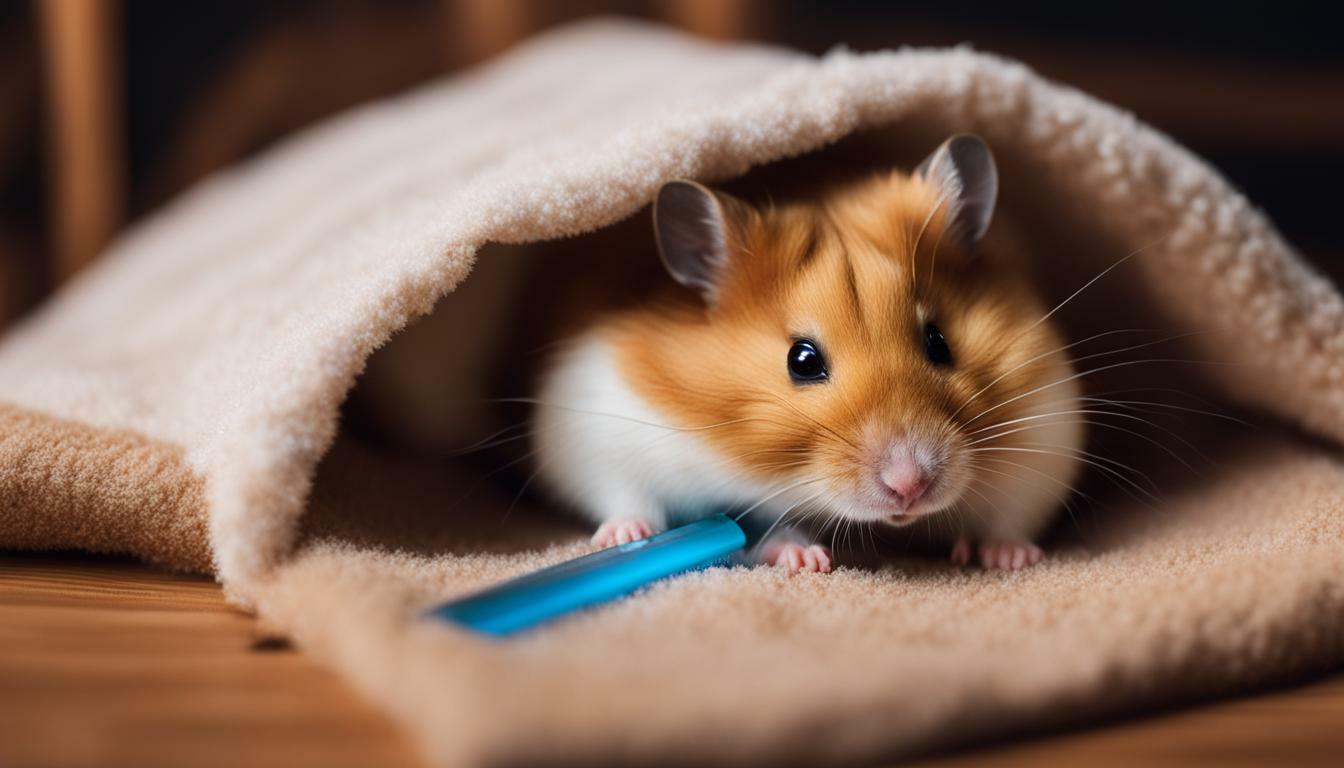Hamsters, like any other pets, require specific temperature conditions to ensure their optimal health and comfort. Maintaining the right temperature is crucial for their well-being, as extremes can pose significant risks. In this section, we will explore the ideal temperature range for hamsters and offer practical tips on how to provide a suitable environment for them.
Key Takeaways:
- The ideal temperature range for hamsters is between 65°F to 75°F.
- Temperatures below this range can put hamsters at risk of health problems, including attempted hibernation.
- Ways to keep hamsters warm include using a space heater, providing a heated pad, using fluffy bedding, and offering nesting material.
- Avoid exposing hamsters to temperatures above 90°F and direct sunlight.
- Hamsters rely more on smell and hearing for navigation, so leaving a light on at night is unnecessary.
The Importance of Maintaining the Right Temperature
Understanding why the right temperature is essential for hamsters is crucial in providing them with a suitable living environment. Hamsters are small animals with a high metabolism, and their bodies rely heavily on external factors to maintain a stable temperature. Failure to maintain the appropriate temperature range can lead to various health issues and discomfort for your furry friend.
Hamsters have specific temperature requirements to ensure their well-being. The optimal living temperature for hamsters is between 65°F to 75°F (18°C to 24°C). When the temperature drops below this range, hamsters may attempt to hibernate, which can be dangerous for their health. On the other hand, exposing hamsters to temperatures above 90°F (32°C) can cause heat stress and potentially lead to heatstroke.
To keep your hamster warm during cooler temperatures, there are several measures you can take. Placing a space heater in the room where the hamster’s habitat is located can help maintain a comfortable temperature. You can also consider using a heated pad specifically designed for small pets. Additionally, keeping the habitat in a smaller room with proper ventilation can help retain warmth. Using fluffy bedding and providing nesting material will assist in retaining your hamster’s body heat and ensuring their comfort.
It’s imperative to avoid exposing your hamster to extreme temperatures. Placing the habitat in direct sunlight or too close to heat sources can result in overheating and put your hamster’s health at risk. Furthermore, leaving a light on at night is unnecessary since hamsters rely more on their sense of smell and hearing than their poor eyesight.
Hamster Temperature Requirements: Key Points
- Hamsters should be kept in a temperature range of 65°F to 75°F (18°C to 24°C).
- Temperature extremes can put hamsters at risk of health problems, including hibernation attempts in colder temperatures and heat stress in hotter conditions.
- Practical ways to keep your hamster warm include using a space heater, providing a heated pad, keeping the habitat in a smaller room with proper ventilation, using fluffy bedding, and offering nesting material.
- Avoid exposing hamsters to temperatures above 90°F (32°C) and refrain from placing the habitat in direct sunlight or too close to heat sources.
- Hamsters do not require a light on at night as they rely more on their sense of smell and hearing for navigation.

| Hamster Temperature Guidelines | Comfort Temperature Range |
|---|---|
| Recommended temperature for hamsters | 65°F to 75°F (18°C to 24°C) |
| Temperature range to avoid | Above 90°F (32°C) |
Recommended Temperature Range for Hamsters
Experts suggest that hamsters thrive best when they are exposed to a specific temperature range. This ideal temperature range for hamsters is typically between 65°F and 75°F. It is crucial to maintain the temperature within this range to ensure the health and well-being of your furry friend.
When the temperature drops below this range, hamsters may attempt to hibernate, which can be dangerous for their health. To keep your hamster warm in cooler temperatures, there are several strategies you can employ. You can use a space heater in the room where the hamster’s habitat is located to provide a consistent source of warmth. Additionally, you can use a heated pad designed for small pets, which can be placed underneath the habitat to provide extra warmth.
Another important factor to consider is the placement of the hamster’s habitat. It’s recommended to keep the habitat in a smaller room with adequate ventilation as this helps to retain heat. Ensure that the habitat is not placed in direct sunlight or too close to heat sources, as this can lead to overheating. Fluffy bedding can also help to maintain warmth, and providing nesting material allows your hamster to create a cozy environment that retains body heat.
| Temperature Range | Recommended Actions |
|---|---|
| Below 65°F | Use a space heater or heated pad |
| Around 70°F | Provide fluffy bedding and nesting material |
| Above 75°F | Avoid exposure to high temperatures |
It’s important to note that hamsters are more reliant on their sense of smell and hearing rather than their poor eyesight for navigation. Therefore, it is unnecessary to leave a light on at night for them. By maintaining the recommended temperature range and taking appropriate measures to keep your hamster warm, you can ensure their comfort and overall well-being.

Extreme temperatures can have adverse effects on the health and comfort of your hamster. It is crucial to maintain the ideal temperature range of 65°F to 75°F in their habitat to ensure their well-being. If the temperature drops below this range, your hamster may attempt to hibernate, which can put them at risk of health problems. Taking the necessary steps to keep your hamster warm is essential.
To help regulate the temperature in their habitat, you can consider using a space heater in the room where the hamster’s home is located. This will provide a consistent and comfortable temperature for your furry friend. Additionally, you can also provide a heated pad designed for small pets, which can be placed under a portion of the habitat to create a warm spot for your hamster to snuggle up.
“Extreme temperatures can have adverse effects on the health and comfort of your hamster.”
Another way to ensure your hamster’s comfort is by keeping the habitat in a smaller room with adequate ventilation. This will make it easier to maintain a stable temperature, as a larger room may be more prone to temperature fluctuations. Additionally, using fluffy bedding can help provide insulation and warmth for your hamster. It’s also a good idea to offer nesting material, such as shredded paper or tissue, as this will allow your hamster to create a cozy nest and retain body heat.

It’s important to be aware of the potential risks of exposing your hamster to high temperatures as well. Temperatures above 90°F can be dangerous and can lead to heat stroke or even death. Therefore, it’s crucial that you avoid placing the habitat in direct sunlight or too close to heat sources, such as radiators or heating vents. Ensuring proper ventilation in the room and providing a cool spot, such as a ceramic tile or a chilled stone, can also help prevent overheating.
Remember, hamsters rely more on their sense of smell and hearing rather than their poor eyesight for navigation. Therefore, there’s no need to leave a light on at night, as darkness is natural and comforting for them. By taking these steps and maintaining a suitable temperature range, you can ensure the health, comfort, and well-being of your beloved hamster.
Keeping Hamsters Warm in Cooler Temperatures
When the temperature drops below the recommended range, it’s important to take measures to keep your hamster warm and comfortable. Hamsters are sensitive to cold temperatures and can develop health issues if not properly cared for. Here are some tips to help you maintain the ideal temperature for your furry friend:
1. Provide a cozy habitat
Ensure that your hamster’s habitat is well-insulated to retain heat. You can use a smaller room or create a designated area with limited drafts and good ventilation. Use bedding materials that are fluffy and provide insulation, such as shredded paper or soft wood shavings. This will help your hamster stay warm and cozy even in cooler temperatures.
2. Use supplementary heating
If the room temperature is consistently lower than the recommended range, you can use a space heater to warm up the area where the hamster’s habitat is located. Make sure to place the heater at a safe distance from the cage to prevent any accidents and avoid direct exposure of the hamster to the heat source.
3. Utilize heating pads
Another option is to use a heated pad specifically designed for small pets. These pads provide a warm surface for your hamster to rest on and regulate their body temperature. Place the heating pad under a portion of the cage floor, ensuring that it covers only a small area so that the hamster can choose to move closer or farther away from the heat source as needed.

Hamsters are natural nest builders, and providing them with nesting material helps them retain body heat. Offer soft bedding materials like torn-up tissue paper or unscented paper towels. Your hamster will use it to create a warm, cozy nest where they can curl up and regulate their temperature.
By following these tips, you can ensure that your hamster stays warm and comfortable, even in cooler temperatures. Remember to monitor the temperature regularly and make adjustments as necessary to keep your furry friend happy and healthy.
Avoiding High Temperatures for Hamsters
While it’s important to maintain the right temperature range, it’s equally crucial to avoid exposing your hamster to excessively high temperatures. Hamsters are sensitive to heat and can suffer from heat stroke, dehydration, and even death if exposed to temperatures above 90°F. To keep your furry friend cool and comfortable, follow these guidelines:
- Choose a suitable location: Place the hamster’s habitat away from direct sunlight and sources of heat, such as radiators or heating vents. Opt for a cooler room in your home, preferably with good ventilation.
- Provide adequate airflow: Avoid enclosing the habitat in a small, confined space that restricts airflow. Proper ventilation helps dissipate excess heat and prevents the buildup of hot air around your hamster.
- Use appropriate bedding: Opt for bedding that allows for better heat dissipation, such as aspen shavings or shredded paper. Avoid using cedar or pine bedding, as they can release aromatic oils that may irritate your hamster’s respiratory system.
- Offer cooling options: Place a ceramic tile or a chilled ice pack wrapped in a cloth inside the habitat to provide a cool surface for your hamster to rest on. You can also freeze a ceramic dish or a water bottle partially filled with water and place it in the habitat.
Remember, hamsters are more sensitive to high temperatures than humans, so it’s essential to take steps to prevent overheating. Monitor the temperature regularly and be aware of signs of distress in your hamster, such as excessive panting, drooling, or lethargy. By providing a suitable environment and taking preventive measures, you can ensure your hamster stays happy and healthy.

| Signs of Overheating in Hamsters: | Preventive Measures: |
|---|---|
| Rapid, shallow breathing | Place a frozen water bottle wrapped in a cloth inside the habitat |
| Excessive thirst | Offer fresh, cool water in a shallow dish |
| Lack of appetite | Keep the habitat in a cooler room with good airflow |
| Lethargy or weakness | Provide a cool surface for your hamster to rest on, such as a ceramic tile |
Proper Habitat Placement and Bedding Selection
The location of your hamster’s habitat and the bedding you choose can play a significant role in maintaining the right temperature for your pet. Ensuring that the habitat is placed in a suitable area will help regulate the living temperature for your hamster, keeping them comfortable and healthy.
When selecting the location for your hamster’s habitat, it’s important to avoid extremes in temperature. Keep the habitat away from direct sunlight and sources of heat such as radiators or vents, as these can cause the temperature to rise above the recommended range. Instead, choose a room that stays within the optimal temperature range of 65°F to 75°F.
In addition to proper habitat placement, choosing the right bedding is crucial for temperature regulation. Opt for fluffy bedding materials that can provide insulation and help retain warmth. Materials such as aspen shavings, paper-based bedding, or hemp bedding are excellent options. Avoid using cedar or pine shavings, as they can release aromatic oils that may irritate your hamster’s respiratory system.
Creating a comfortable and temperature-controlled environment for your hamster is essential for their well-being. By carefully selecting the habitat location and using suitable bedding materials, you can ensure that your furry friend stays within the recommended temperature range and enjoys a cozy home.

| Recommended Temperature Range for Hamsters | Potential Health Risks of Temperature Extremes |
|---|---|
| 65°F to 75°F | Extreme cold can lead to hibernation attempts and health problems. Extreme heat can cause dehydration, heat stroke, and even death. |
Additional Considerations for Temperature Management
In addition to the temperature range, there are other factors that contribute to your hamster’s overall comfort and well-being. Proper ventilation is crucial in maintaining a healthy environment for your pet. Ensure that the hamster’s habitat has adequate airflow to prevent the accumulation of moisture, which can lead to respiratory issues. A well-ventilated habitat will help regulate the temperature and maintain the optimal conditions for your furry friend.
Another important consideration is the choice of bedding material. Select bedding that not only provides comfort but also helps with temperature regulation. Fluffy bedding options, such as shredded paper or aspen shavings, create insulation that helps retain body heat. This is especially important in cooler temperatures, as it provides an additional layer of warmth for your hamster.
It is also advisable to avoid sudden temperature changes, as they can be stressful for hamsters. Keep the habitat away from drafty areas, windows, or doors that are frequently opened. Any sudden changes in temperature can disrupt your hamster’s natural balance and potentially compromise its health.
Remember that hamsters have sensitive respiratory systems, so avoid exposing them to any harsh chemicals or strong odors. Perfumes, household cleaners, or strong-smelling products can be detrimental to their well-being. Opt for natural and unscented cleaning solutions when maintaining their habitat.
| Considerations for Temperature Management | Actions to Take |
|---|---|
| Proper Ventilation | Adequate airflow to prevent moisture build-up. |
| Bedding Selection | Choose fluffy bedding for insulation and warmth. |
| Avoiding Sudden Temperature Changes | Keep habitat away from drafty areas and sudden temperature fluctuations. |
| Avoid Harsh Chemicals and Odors | Opt for natural and unscented cleaning solutions. |
Conclusion
Maintaining the ideal temperature for your hamster is crucial in ensuring its health, comfort, and overall well-being. Hamsters thrive in a temperature range of 65°F to 75°F, and deviations from this range can have detrimental effects on their health. When temperatures drop below this range, hamsters may attempt to hibernate, putting them at risk of severe health problems. To prevent this, you can take several measures to keep your hamster warm and cozy.
One effective method is to use a space heater in the room where your hamster’s habitat is located. This will help maintain a warm and comfortable environment for your furry friend. Additionally, you can provide a heated pad specifically designed for small pets, which will offer an extra source of warmth. It’s important to ensure that your hamster’s habitat is placed in a smaller room with adequate ventilation to prevent any heat buildup.
Choosing the right bedding is another important aspect of temperature management. Opt for fluffy bedding materials that can provide insulation and retain heat, keeping your hamster cozy throughout the day. Providing nesting material, such as shredded paper or soft fabric, will allow your hamster to create a warm nest and trap body heat.
While it’s crucial to keep your hamster warm, it’s equally important to avoid exposing them to temperatures above 90°F. High temperatures can lead to heat stroke and other heat-related issues. Avoid placing the habitat in direct sunlight or too close to heat sources, such as radiators or heating vents. Additionally, remember that hamsters rely more on their sense of smell and hearing for navigation, so there is no need to leave a light on at night as it may disturb their natural sleep patterns.
In conclusion, maintaining the ideal temperature range for your hamster is essential for its well-being. By providing a warm and comfortable environment, you can ensure that your furry friend stays happy and healthy. Remember to monitor the temperature regularly and make adjustments as needed to keep your hamster safe and comfortable.
FAQ
Q: What is the ideal temperature range for keeping hamsters?
A: Hamsters should ideally be kept in a temperature range of 65°F to 75°F.
Q: Why is it important to maintain the right temperature for hamsters?
A: Maintaining the appropriate temperature is crucial for the health and well-being of hamsters as temperature extremes can put them at risk of health problems.
Q: What are the potential health risks of temperature extremes for hamsters?
A: Temperature extremes can cause hamsters to attempt to hibernate, which can be detrimental to their health. It’s important to prevent this by maintaining a suitable temperature range.
Q: How can I keep my hamster warm in cooler temperatures?
A: To keep your hamster warm in cooler temperatures, you can use a space heater in the room where the habitat is located, provide a heated pad designed for small pets, keep the habitat in a smaller room with adequate ventilation, use fluffy bedding to ensure warmth, and offer nesting material for your hamster to retain body heat.
Q: How can I prevent my hamster from overheating?
A: To prevent your hamster from overheating, it’s important to avoid exposing them to temperatures above 90°F and to not place the habitat in direct sunlight or too close to heat sources.
Q: Are there any additional considerations for managing the temperature for my hamster?
A: Yes, you should also consider proper habitat placement and bedding selection. Ensure the hamster’s habitat is located in an appropriate room and choose bedding that helps regulate temperature. Also, provide adequate ventilation and nesting material for your hamster.




